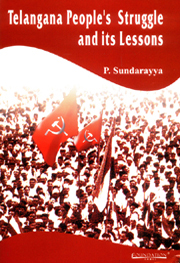Book contents
- Frontmatter
- Contents
- Preface
- Introduction
- PART I
- PART II
- 1 Entry of Indian Army and Immediately After
- 2 Terror Regime and Resistance
- 3 The Krishna Forest (Nallamala) Region
- 4 The Godavari Forest Region
- 5 Actions of Guerrilla Squads
- 6 People's Upsurge in Karimnagar and other New Areas
- 7 Movement in Cities and of the Working Class
- 8 Struggle Inside Jails
- 9 Women in the Telangana Movement
- 10 Brief Sketches of Some of the Squad and Party Leaders: after the Entry of the Indian Army
- 11 Withdrawal of Telangana Armed Partisan Resistance
- Epilogue
- PART III
6 - People's Upsurge in Karimnagar and other New Areas
from PART II
Published online by Cambridge University Press: 05 November 2011
- Frontmatter
- Contents
- Preface
- Introduction
- PART I
- PART II
- 1 Entry of Indian Army and Immediately After
- 2 Terror Regime and Resistance
- 3 The Krishna Forest (Nallamala) Region
- 4 The Godavari Forest Region
- 5 Actions of Guerrilla Squads
- 6 People's Upsurge in Karimnagar and other New Areas
- 7 Movement in Cities and of the Working Class
- 8 Struggle Inside Jails
- 9 Women in the Telangana Movement
- 10 Brief Sketches of Some of the Squad and Party Leaders: after the Entry of the Indian Army
- 11 Withdrawal of Telangana Armed Partisan Resistance
- Epilogue
- PART III
Summary
The Andhra Mahasabha was well-established among the people of Karimnagar district even before the movement against the Nizam-Razakar regime had started. During 1947–1948, Andhra Mahasabha workers, under the leadership of the Communist Party, organised themselves into guerrilla squads and fought against the terror regime. Comrades Prabhakar Rao, Damodar Reddy and Bhupati Reddi and some squad leaders were killed by the enemy in those actions. The armed struggle in that district received a serious set-back. But among the people, the hatred against the Nizam-Razakar regime mounted. They were eagerly awaiting the advent of the guerrilla squads and the Communist leaders, stories of whose heroic defence of the toiling masses against the Union armies in the neighbouring districts, were inspiring them.
When the Party ultimately sent a few organisers and three guerrilla squads to extend the movement in the Karimnagar-Adilabad area, the peasants and the agricultural labourers received them with tremendous enthusiasm, and started confiscating the grain and properties of the hated landlords, and destroying their fortress bungalows. During the short period of three months, May – July 1950, the people confiscated 1,000 bags of foodgrains and had it distributed, as well as two lakh rupees worth of household goods and agricultural implements. They razed to the ground 12 bungalows of the landlords and liquidated 16 police personnel and 26 police informers, goondas and landlords.
The police and government officials were nervous, afraid of the guerrilla attacks. One night somebody focussed a torchlight on the police station. The sentry and others almost ran away in panic thinking that the guerrillas had arrived.
- Type
- Chapter
- Information
- Telengana People's Struggle and it's Lessons , pp. 212 - 223Publisher: Foundation BooksPrint publication year: 2006

